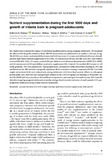| dc.contributor.author | Dewey, Kathryn G. | |
| dc.contributor.author | Matias, Susana L. | |
| dc.contributor.author | Mridha, Malay K. | |
| dc.contributor.author | Arnold, Charles D. | |
| dc.date.accessioned | 2022-04-13T07:38:45Z | |
| dc.date.available | 2022-04-13T07:38:45Z | |
| dc.date.copyright | 2020 | |
| dc.date.issued | 2020-05 | |
| dc.identifier.citation | Dewey, K. G., Matias, S. L., Mridha, M. K., & Arnold, C. D. (2020). Nutrient supplementation during the first 1000 days and growth of infants born to pregnant adolescents. Annals of the New York Academy of Sciences, 1468(1), 25–34. https://doi.org/10.1111/nyas.14191 | en_US |
| dc.identifier.uri | http://hdl.handle.net/10361/16548 | |
| dc.description | This article was published in Annals of the New York Academy of Sciences [ © 2019 The Authors. Annals of the New York Academy of Sciences 25 published by Wiley Periodicals, Inc. on behalf of New York Academy of Sciences] and the definite version is available at: https://doi.org/10.1111/nyas.14191 The Journal's website is at: https://nyaspubs.onlinelibrary.wiley.com/doi/epdf/10.1111/nyas.14191 | en_US |
| dc.description.abstract | Few studies have evaluated the impact of nutritional supplementation among pregnant adolescents. We examined
the effects of the Rang Din Nutrition Study (RDNS) interventions on children born to mothers <20 years of age.
The RDNS was a cluster-randomized effectiveness trial with four arms: (1) women and children both received smallquantity lipid-based nutrient supplements (LNS-LNS), (2) women received iron and folic acid (IFA) and children
received LNS (IFA-LNS), (3) women received IFA and children received micronutrient powder (MNP) (IFA-MNP),
and (4) women received IFA and children received no supplements (IFA-Control). We enrolled 4011 women at <20
weeks gestation; 1552 were adolescents. Among adolescents, prenatal LNS reduced newborn stunting by 25% and
small head size by 28% and had a marginally significant effect on newborn wasting, compared with IFA. Low birth
weight and preterm birth were reduced only among adolescents with lower food security. Effects on subsequent
growth status were observed only among female children in the LNS-LNS group: less stunting at 18 months (versus IFA-MNP) and lower prevalence of small head circumference and wasting at 24 months (versus IFA-Control).
Initiatives targeting pregnant adolescents in similar settings should consider inclusion of small-quantity LNS, particularly for adolescents living in food-insecure households. | en_US |
| dc.language.iso | en_US | en_US |
| dc.publisher | Annals of the New York Academy of Sciences | en_US |
| dc.relation.uri | https://nyaspubs.onlinelibrary.wiley.com/doi/epdf/10.1111/nyas.14191 | |
| dc.subject | Prenatal nutrition | en_US |
| dc.subject | Low birth weight | en_US |
| dc.subject | Stunting | en_US |
| dc.subject | Lipid-based nutrient supplements | en_US |
| dc.subject | Child growth | en_US |
| dc.title | Nutrient supplementation during the first 1000 days and growth of infants born to pregnant adolescents | en_US |
| dc.type | Journal Article | en_US |
| dc.description.version | Published | |
| dc.contributor.department | Brac James P. Grant School of Public Health | |
| dc.identifier.doi | https://doi.org/10.1111/nyas.14191 | |

